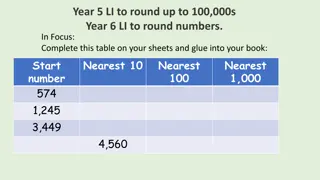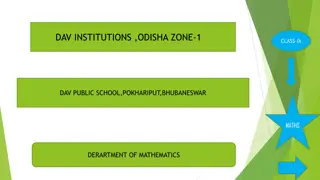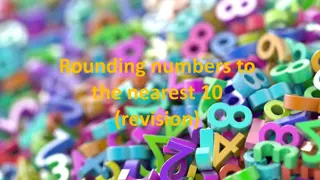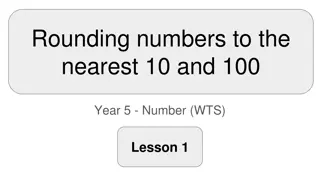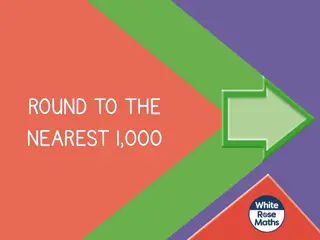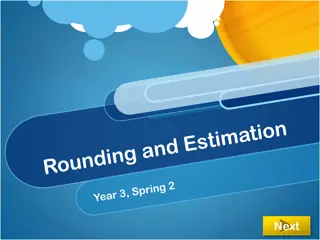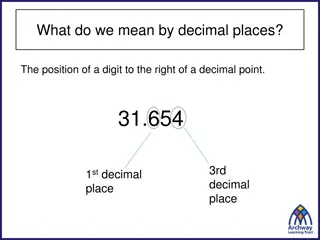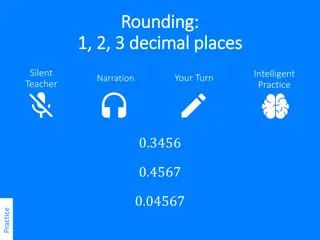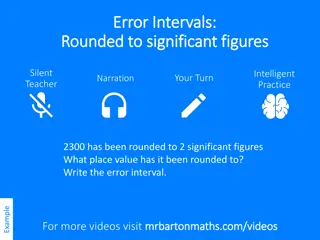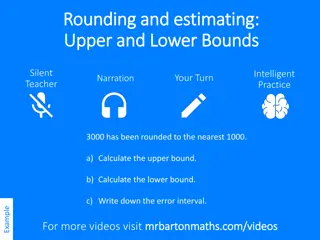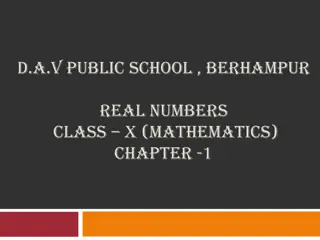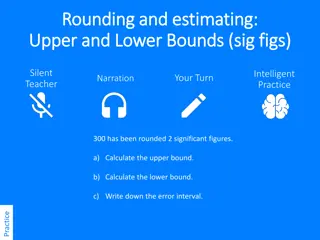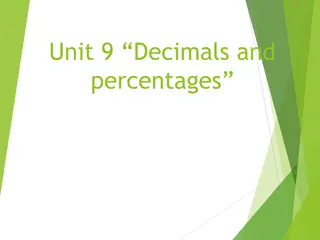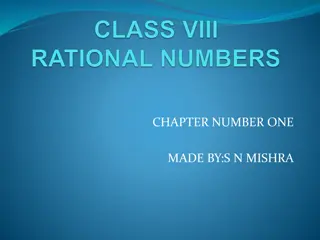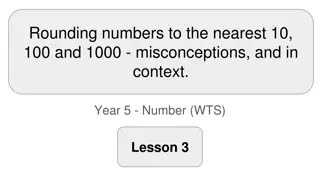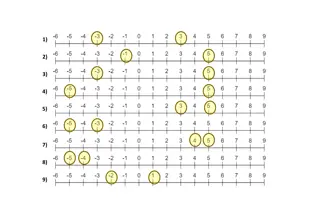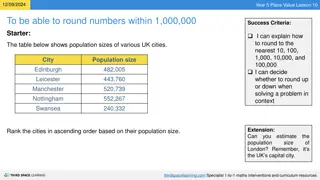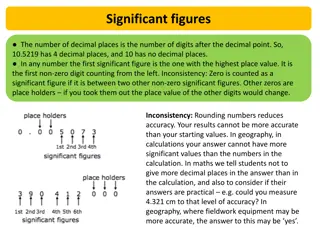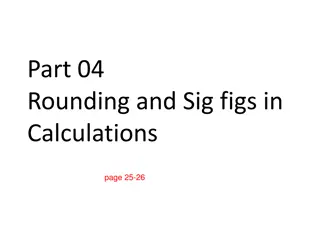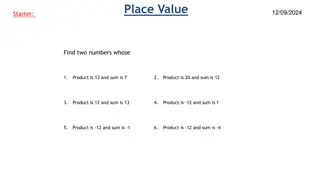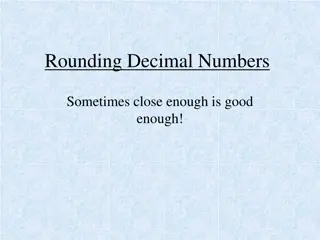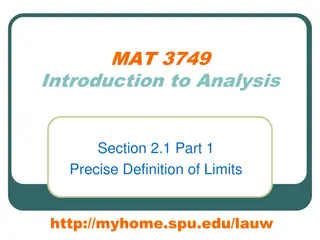Rounding Numbers and Establishing Limits in Mathematical Accuracy
Performing rounding calculations to the nearest 10 and 1 decimal place, understanding limits of accuracy in measurements, analyzing potential accuracy problems in precision engineering, and exploring the concept of upper and lower bounds within mathematical contexts.
Download Presentation

Please find below an Image/Link to download the presentation.
The content on the website is provided AS IS for your information and personal use only. It may not be sold, licensed, or shared on other websites without obtaining consent from the author.If you encounter any issues during the download, it is possible that the publisher has removed the file from their server.
You are allowed to download the files provided on this website for personal or commercial use, subject to the condition that they are used lawfully. All files are the property of their respective owners.
The content on the website is provided AS IS for your information and personal use only. It may not be sold, licensed, or shared on other websites without obtaining consent from the author.
E N D
Presentation Transcript
Starter Round the following numbers to the nearest 10: 1. 37 2. 755 3. 754.999999999 4. 10 5. 10483923 Round the following numbers to 1 decimal place: 1. 0.345 2. 0.269 3. 3.34 4. 2.98 5. 19.99
Answers Round the following numbers to the nearest 10: 1. 40 2. 760 3. 750 4. 10 5. 10483920 Round the following numbers to 1 decimal place: 1. 0.3 2. 0.3 3. 3.3 4. 3.0 5. 20.0
Can you answer this? An IMAX cinema screen is 22m by 16m to the nearest metre. Calculate the limits of accuracy for the area of the screen.
A company building a new formula one car decides to order its nuts and bolts to an accuracy of 0.1 mm. What problems could this cause? 5 mm 0.1mm 5 mm 0.1mm
A number has been rounded to the nearest whole number, what could it have been? If it was rounded up, it could have been? 5 4.61 4.5 If it was rounded down, it could have been? 4.9 4.87 5.1 5.34 5.48 5.4999 999999 9999 5.5 What s the smallest number it could have been? What s the biggest number it could have been?
The Empire State Building is 443m tall, to the nearest metre. 444 443.5 442.5 Height < 443.5 Limits of Accuracy 443 442.5 442
These numbers have been rounded to the nearest 10, write down the largest and smallest values they could be. Express your answers as inequalities in terms of x: a. 50 b. 80 45 x < 55 75 x < 85 c. 110 105 x < 115 These numbers have been rounded to the nearest whole number, write down the upper and lower bounds. Express your answers as inequalities in terms of x: a. 3 b. 17 2.5 x < 3.5 17.5 x < 18.5 c. 100 99.5 x < 100.5 These lengths have been rounded to the nearest tenth, write the upper and lower limits. Express your answers as inequalities in terms of x: a. 12.5cm b. 21.7cm 12.45 x < 12.5521.65 x < 21.7552.05 x < 52.15 c. 52.1cm
A room is measured as 6.4 x 4.3 metres, measured to 1 decimal place. Calculate the upper and lower bounds of the area of floor in the room. LB = 6.35 m 6.4 m UB = 6.45 m UB = 4.35m 4.3 m LB = 4.25 m Minimum area = 6.35 x 4.25 = 26.9875 m Maximum area = 6.45 x 4.35 = 28.0575 m 26.9875 m A < 28.0575
A room is measured as 6.4 x 4.3 metres, measured to 1 decimal place. What about the minimum and maximum length of the skirting board? LB = 6.35 m 6.4 m UB = 6.45 m UB = 4.35m 4.3 m LB = 4.25 m Maximum length = 2 (6.45 + 4.35) = 21.6 m Minimum length = 2 x (6.35 + 4.25) = 21.2 m 21.2 m L < 21.6 m
The Bugatti Veyron can travel 800 metres (to the nearest 10m) in 4.4 seconds (to the nearest 1dp). Calculate the upper and lowers bounds of its maximum speed to 3 significant figures. Lower bound = LB distance UB time Upper bound = UB distance LB time = 795 4.45 = 178.651685 m/s = 805 4.35 = 185.057471 m/s 179 m/s S < 185 m/s
Can you answer this? An IMAX cinema screen is 22m by 16m to the nearest metre. Calculate the limits of accuracy for the area of the screen. 333.25 m2 Area < 371.25 m2
Upper and Lower Bounds 1. A field is 100 m wide and 120 m long to the nearest metre. a) Find the perimeter and area of the field if these measurements are accurate. b) Find the largest and smallest possible perimeter. c) Find the largest and smallest possible area. 2. A rectangle s area is 40 cm to the nearest whole number. One side of the rectangle is exactly 10 cm. Find the maximum and minimum lengths the other side could have. 3. Usain Bolt runs 100 m, to the nearest metre, in 9.6 seconds, to the nearest tenth of second. a) What are the greatest and least possible times for Usain? b) What are the greatest and least possible lengths of the track? c) What is the fastest possible average speed for Usain?
Answers 1. a) b) c) P = 440 m, A = 12000 m 438 m P< 442 m 11890.25 m A < 12110.25m 2. 3.95cm length < 4.05cm 3. a) b) c) 9.55 seconds T 9.65 seconds 99.5 m L < 100.5 m 10.52 m/s


